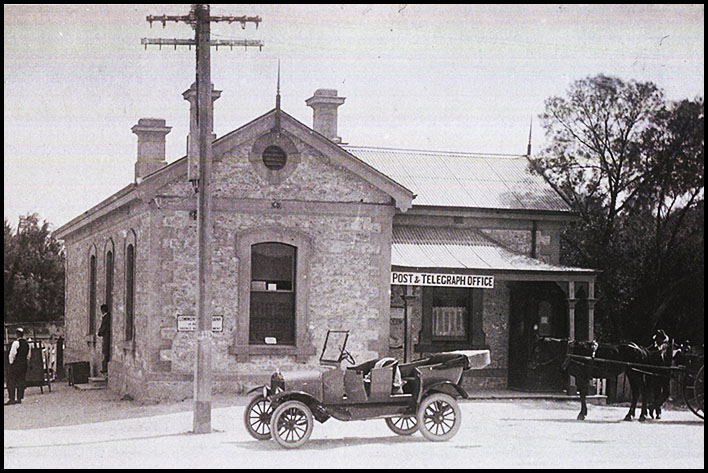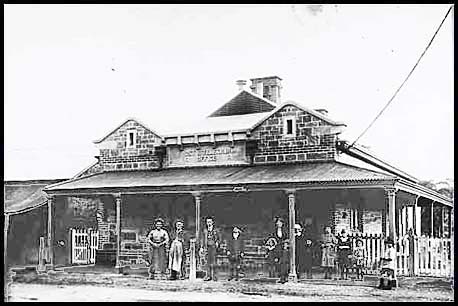Telegraph Offices on the line to the South.
- Home, index, site details
- Australia 1901-1988
- New South Wales
- Overview of NSW
- Telegraph lines
- Telegraph Offices
- Date stamps
- Forms
- Envelopes
- Rates
- Stamps
- Queensland
- Overview of Qld
- Telegraph lines
- Telegraph offices
- Date stamps
- Forms
- Envelopes
- Rates
- Stamps
- South Australia
- Overview of SA
- Telegraph lines
- Telegraph Offices
- Date stamps
- Forms
- Envelopes
- Rates
- Stamps
- Tasmania
- Overview of Tasmania
- General developments
- Reports
- Organisation
- Telegraph lines
- Telegraph Offices
- Date stamps
- Railway lines
- Forms
- Envelopes
- Rates
- Stamps
- Overview of Tasmania
- Victoria
- Overview of Vic.
- Telegraph lines
- Telegraph offices
- Date stamps
- Forms
- Envelopes
- Rates
- Stamps
- Ephemera
- Western Australia
- Overview of WA
- Telegraph lines
- Telegraph Offices
- Date stamps
- Forms
- Envelopes
- Rates
- Stamps
|
The Post & Telegraph Office opened on 19 December 1874. Mrs. Machel - formerly of the Normanville Office - was in charge. The Minister of Education told a deputation, on 11 July 1873, that money had been voted for a Post & Telegraph Office and that construction would start when a site had been decided upon. Work began at the end of March 1874 - the site being opposite the Aldinga Hotel. It was expected that the completed building would be "an ornament to the township". On its completion, the Weekly Chronicle of 3 October 1874 said "After being nearly six months in course of erection, the new post and telegraph office is finished. It contains five rooms, besides the office and, having been built with very pretty stone, presents a neat appearance, and is quite an ornament to the township". |
|
|
The Telegraph Office opened in ?? 1879. In September 1878, " there was a prospect of our long-talked of telegraph line being commenced. It has been pegged and surveyed and tenders called for its construction". |
|
The Telegraph Office was opened on 7 June 1879, |
| Glenelg.
The Telegraph Office opened on 3 September 1859. On 1 August 1861, a group of 38 residents petitioned the House for the Post Office to be removed to the Telegraph Office. A large new office was constructed in 1880 which included additions to the residence. The cost was £828. In 1902 a cable station was opened at/near Glenelg as the shore station for the Cape-Cottesloe-Glenelg submarine cable. |
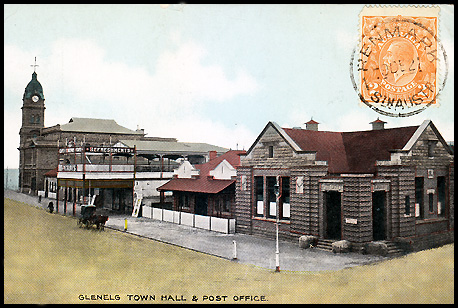 Glenelg Post Office and Town Hall in early 1900s. |
 Glenelg Post & Telegraph Office about 1911. TELEGRAPH can be seen above the righ hand door. |
|
Early postal date stamps began to be used on telegrams. Those for Glenelg were framed. Diameter: 22 mm. The example shown to the right is the earliest use of a Number of examples used on a telegram in the Census: 1. |
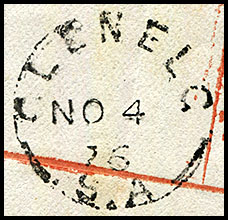 4 November 1876. Used on SC-DO-4A. |
A steel circular TELEGRAPH date stamp (RC1 - T) was used at Glenelg.
|
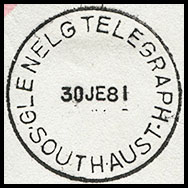 30 June 1981. |
|
The Post Office at Meadows was opened on 18 July 1850. It then closed on 29 February 1852 but was relisted as a Post Office on 1 January 1855. Telephone facilities were established in May 1900. Presumably the Telegraph facilities began operation soon after. |
|
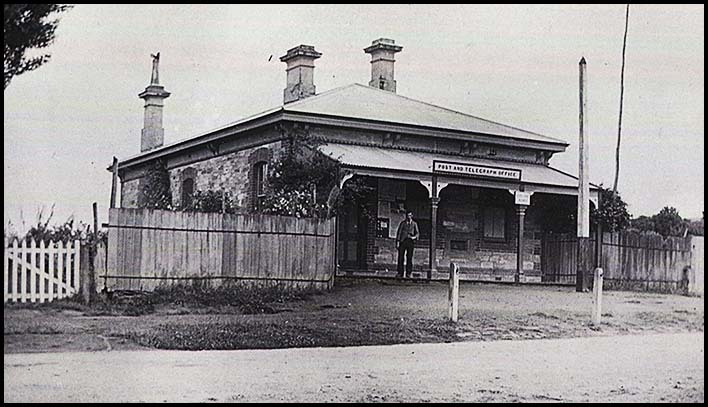 Meadows P&TO about 1902. |
|
|
The Adelaide Observer of 3 June 1865 reported that "Mr. COLTON presented a petition, signed by 34 persons in the district of Noarlunga, praying that the House would vote a sufficient sum for erecting a telegraphic station in the township of Noarlunga". The telegraph line opened on 5 April 1866. Charles Todd opened the line and used a portable battery he had brought with him to send the usual congratulatory messages as well as a few private telegrams. The officer in charge of the Railway Telegraph Station was responsible for the instrument. On 19 Aug. 1891, £650 was gazetted for a new P&T Office - and this building was opened on 30 August 1892. |
|
|
The Adelaide to Normanville telegraph line was completed on 22 September 1862. The Telegraph Office opened in 1863 when the Telegraph Office in Yankalilla was transferred to Normanville. |
|
|
A Telegraph Office was opened at Willunga in 1857. A Post Office had been opened on 14 July 1849 at the Police Station. In a debate in the House on 5 August 1861, Mr. Blyth noted that "he did not think agriculturists were likely to make use of the telegraph. He had nothing to do with the building of the Willunga Station". |
